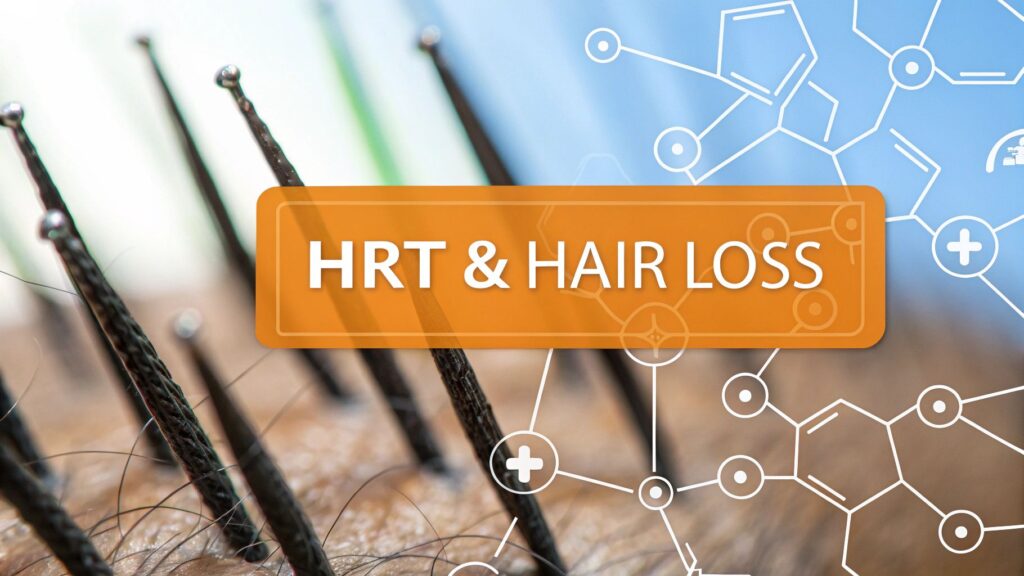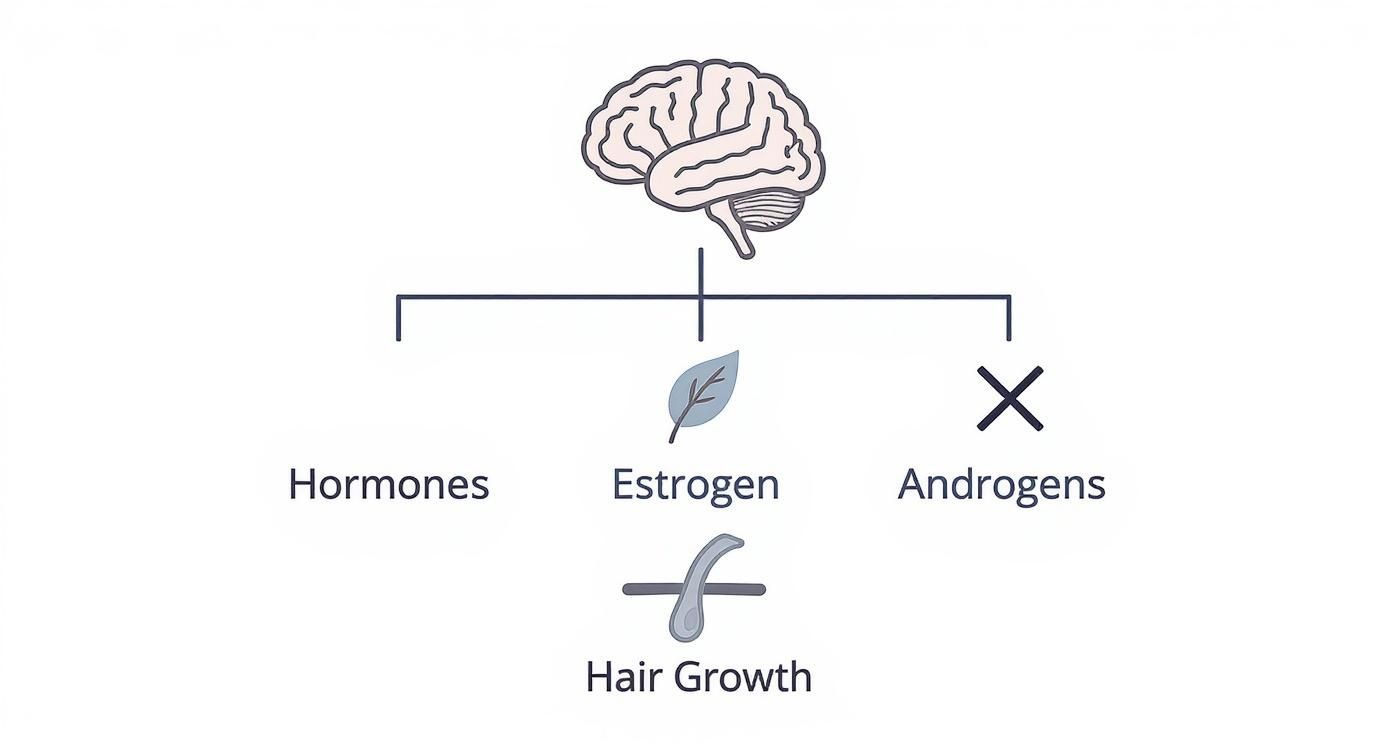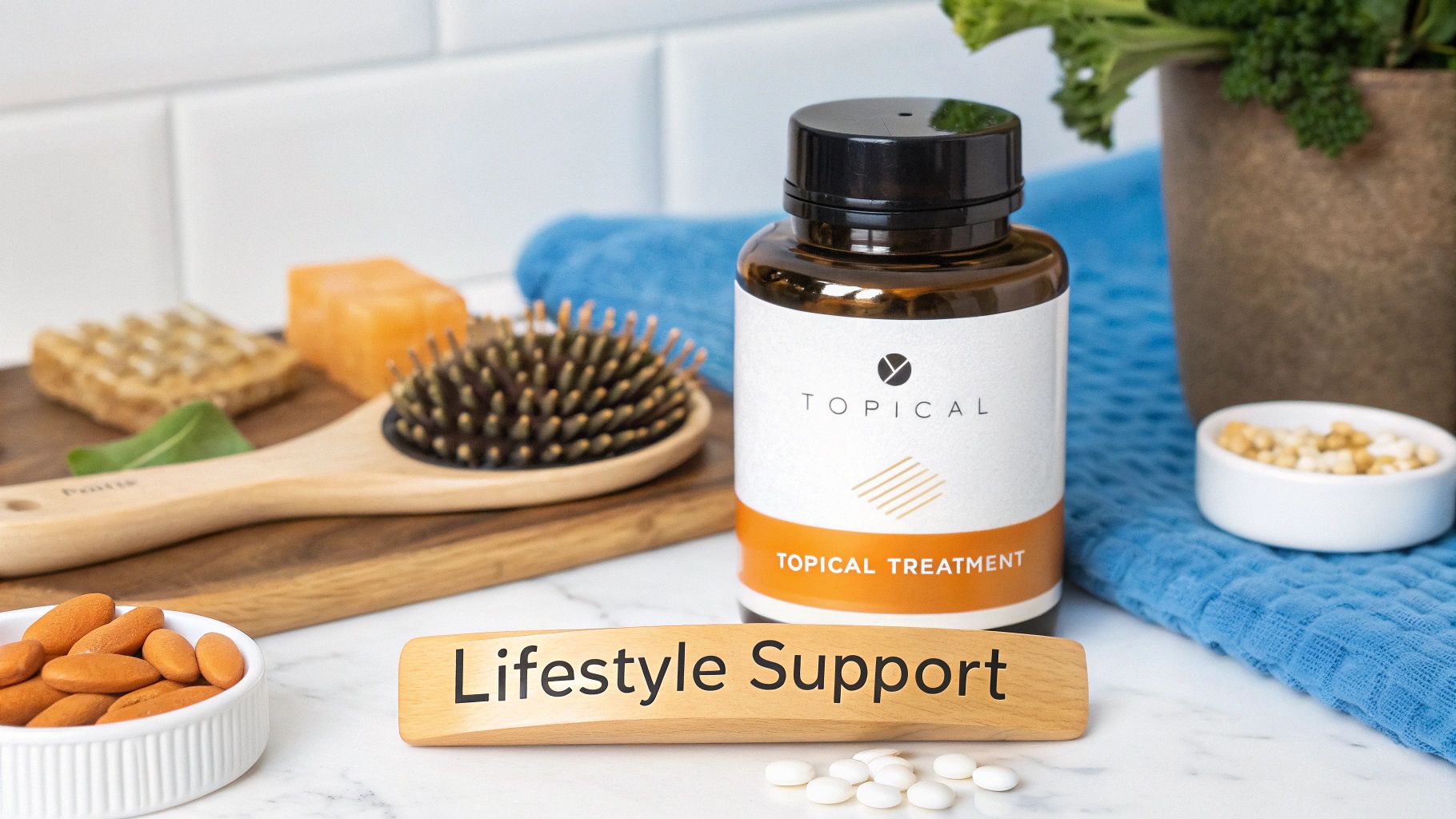Hormone Replacement Therapy and Hair Loss Explained

When it comes to hormone replacement therapy and hair loss, the relationship isn't always straightforward. While the whole point of HRT is to bring your body back into balance, some formulas can accidentally trigger thinning. Others, however, can make a huge difference, dramatically improving hair density. It really comes down to the specific hormones being used and how your own body responds.
Understanding How Hormones Influence Your Hair
The health of your hair is deeply tied to your hormonal landscape, especially during a major shift like menopause. It helps to think of your hair growth cycle as a carefully tended garden. Some hormones act like nurturing gardeners, making everything flourish, while others can come in and wreck the entire system.
To really get a handle on this, we need to look at the two main players on the field: estrogen and androgens.
Estrogen: The Hair Protector
Estrogen is a cornerstone hormone for women's health, and it plays a wonderfully supportive role for your hair. Its main job is to extend the anagen, or "growing," phase of the hair cycle. This simply means each strand of hair stays on your head longer, giving you that fuller, denser look we all want.
When your estrogen levels are where they should be, your "hair garden" thrives. The growth cycles are long and strong, leading to healthy, resilient hair. This is a big reason why many women say their hair was at its absolute best during pregnancy when estrogen levels are sky-high.
Androgens: The Disruptors
On the flip side, we have androgens, which are often called "male hormones" like testosterone—though women have them too, just in smaller amounts. The real troublemaker is a potent byproduct of testosterone called dihydrotestosterone, or DHT. DHT is the main culprit behind most cases of hormonal hair loss.
Here’s how it works:
- DHT has a knack for binding to the receptors in your hair follicles.
- This connection signals the follicles to shrink, a process known as miniaturization.
- As the follicles get smaller, they can only produce thinner, weaker, and shorter hairs.
- Eventually, these miniaturized follicles might just give up and stop producing hair altogether.
During menopause, estrogen levels take a nosedive while testosterone levels decline much more slowly. This shift completely upsets the delicate hormonal balance, giving androgens way more influence over your hair follicles. All of a sudden, the protective shield of estrogen is gone, and the disruptive power of DHT takes over, leading to noticeable thinning.
This hormonal shift is the primary driver behind female pattern hair loss (FPHL), a condition that impacts over 21 million women in the United States alone. Research confirms that while certain hormonal therapies can improve hair density, potential side effects often get in the way. You can dig deeper into the science by exploring published studies on hormonal influences on hair.
Your hair follicles are incredibly sensitive to hormonal signals. Even minor shifts can alter their growth patterns, highlighting the importance of achieving and maintaining a state of hormonal balance for women.
How Different HRT Types Affect Hair Health
When it comes to hormone replacement therapy and its impact on your hair, the devil is truly in the details. It’s not a one-size-fits-all solution; the specific hormones in your prescription can either be your hair’s best friend or, in some cases, make thinning worse. The key is understanding how these hormones interact with your body.
Navigating HRT usually leads you to two main paths: estrogen-only therapy or combined therapy, which includes both estrogen and a progestin. Each one has a very different effect on your hair follicles, and knowing the difference is critical.
The Role of Estrogen-Only HRT
Estrogen-only therapy is widely considered the most hair-friendly option out there. As we’ve covered, estrogen is the hormone that helps keep your hair in the anagen (growth) phase for longer. By supplementing your body's declining estrogen levels, this type of HRT directly counters the hormonal shift that leaves hair follicles vulnerable to androgen-driven shrinkage.
This approach is a direct line of support for hair density and strength. Many women on estrogen-only HRT report a noticeable drop in shedding and a real improvement in their hair’s overall health. However, this option is typically reserved for women who have had a hysterectomy, since taking estrogen alone can increase certain health risks for those who still have a uterus. To get a better sense of the different ways this therapy can be administered, you can explore various estrogen replacement therapy options.
This infographic gives a simple visual breakdown of how hormones influence your hair.

As you can see, estrogen works to keep hair in its growth phase, while androgens can tell the follicle to shrink, which is what leads to thinning.
The Nuances of Combined HRT
For most women, HRT involves a combination of estrogen and a progestin. Progestin is a synthetic form of progesterone that’s added to protect the lining of the uterus. This is where things can get a little tricky for your hair.
While estrogen is the hero for your hair, the type of progestin in your HRT formula is the wildcard. Some are neutral or even beneficial, while others can act like androgens and inadvertently trigger hair loss.
Progestins are classified based on their properties. Some have high androgenic activity, which means they can mimic the effects of testosterone and DHT in the body. If your hair follicles are already genetically sensitive to androgens, using an HRT with one of these progestins could unfortunately kickstart or worsen hair thinning.
On the flip side, other progestins have low or even anti-androgenic activity. These are much kinder to your hair and are far less likely to cause shedding. If hair loss is a concern for you, choosing an HRT with a hair-friendly progestin is absolutely essential.
Comparing Common HRT Formulations and Their Impact on Hair
Here is a simplified breakdown of different HRT types to help you understand their potential effects on hair thinning or growth.
| HRT Type | Key Hormones | Potential Impact on Hair | Best Suited For |
|---|---|---|---|
| Estrogen-Only | Bioidentical Estrogen | Generally protective. Helps prolong the growth phase of hair follicles, leading to improved density and reduced shedding. | Women who have had a hysterectomy. |
| Combined (Anti-Androgenic) | Estrogen + Progesterone or an anti-androgenic progestin (e.g., Drospirenone) | Hair-friendly. The progestin component does not mimic testosterone, preserving the hair-protective benefits of estrogen. | Women with a uterus who are concerned about hair thinning. |
| Combined (Androgenic) | Estrogen + an androgenic progestin (e.g., Norethisterone, Levonorgestrel) | Potential for hair loss. The progestin component can act like an androgen, potentially triggering hair thinning in sensitive individuals. | Women who are not sensitive to androgens or for whom hair loss is not a primary concern. |
This table makes it clear that the "progestin" part of the equation is what you really need to pay attention to if you're worried about your hair.
In the end, it all comes down to the specific formula. Research has consistently shown that estrogen helps keep hair follicles in their growth phase. However, the overall success of HRT for preventing hair loss often hinges on making sure all the ingredients in your therapy are working in your hair's favor.
Weighing the Benefits and Risks for Your Hair and Health
Deciding to start hormone replacement therapy is a big deal, and it’s about a lot more than just your hairline. While the chance to get back thicker, healthier hair is a huge motivator, HRT is a systemic treatment. That means it affects your entire body, so it’s best to see it as a comprehensive health strategy, not just a quick fix for thinning hair.
A balanced perspective is everything here. On one hand, the benefits can be genuinely life-changing. Many women find that getting their hormones back in balance not only helps with hair thinning but also brings incredible relief from other disruptive menopausal symptoms.
We're talking about a dramatic drop in hot flashes, more stable moods, better sleep, and a real boost in energy. For many, these perks add up to a massive improvement in their day-to-day quality of life.
Understanding the Potential Downsides
On the other hand, we have to have an honest conversation about the potential risks that come with HRT. These aren't universal—they depend heavily on your unique health profile, the specific type of hormones you use, the dose, and how long you stay on the treatment. Concerns can range from minor annoyances to more serious health considerations.
Some of the primary risks that need a careful discussion with your doctor include:
- Cardiovascular Health: The impact on heart health isn't straightforward. Studies show different outcomes depending on the age you start treatment and the kind of hormones used.
- Blood Clot Risk: Certain forms of HRT, especially oral estrogen, have been linked to a slightly higher risk of developing blood clots.
- Cancer Risk: The connection between HRT and certain cancers, like breast and endometrial cancer, is complex. It remains a key area of ongoing research and discussion.
Your personal and family medical history plays a pivotal role in determining whether HRT is a safe option for you. A thorough evaluation is non-negotiable before beginning any form of hormone therapy.
A Holistic View of Your Health
Ultimately, the goal is to make an informed decision that puts your overall well-being first. This means looking at the full picture—weighing the welcome relief from menopausal symptoms against the potential health risks. The link between hormone replacement therapy and hair loss is just one piece of a much larger puzzle.
The most important step you can take is a detailed consultation with a doctor who truly understands hormonal health. They can help you analyze your individual risk factors against the potential benefits, creating a personalized plan that lines up with your health goals.
To get the most out of that conversation, it helps to understand the full range of potential hormone replacement therapy side effects. This knowledge empowers you to ask the right questions and work as a team with your provider, making sure your health journey is both safe and successful.
Your Guide to Starting HRT for Hair Concerns
Taking the first step toward hormone replacement therapy can feel like a big decision, but breaking down the process makes it much more manageable. The journey to addressing hair loss with HRT isn't something you do alone; it's a partnership between you and your healthcare provider, focused on finding the right balance for your unique body.

It all starts with a thorough consultation. This initial visit is your chance to lay everything on the table—your symptoms, your specific concerns about hair thinning, and your complete medical history. Your doctor needs this complete picture to figure out if HRT is a safe and appropriate option for you.
Initial Diagnostics and Creating Your Plan
To get a precise look at what’s happening under the hood, your doctor will order a series of diagnostic tests. This isn't guesswork; it's about gathering concrete data to understand your personal hormonal landscape.
Key tests often include:
- A Comprehensive Hormone Panel: This blood test measures levels of key players like estrogen, progesterone, and testosterone, including its more potent form, DHT.
- Thyroid Function Tests: An underactive or overactive thyroid can also trigger hair loss, so it's critical to rule this out from the start.
- Nutrient Level Checks: Sometimes, the problem is a deficiency in vital nutrients like iron, vitamin D, or zinc, which can all contribute to shedding.
Once these results are in, your provider can see the full story. This information allows them to craft a personalized treatment plan, selecting the right hormones and dosages designed to restore balance without making your hair situation worse. The goal is to tackle the root cause of your hormone replacement therapy and hair loss concerns head-on.
Setting Realistic Expectations for Results
One of the most important parts of this journey is patience. Hair growth operates on its own slow, stubborn timeline, and the effects of HRT won't show up overnight. Think of it like planting a garden; the seeds need time to sprout and grow strong.
It typically takes three to six months to notice the first signs of improvement, like less shedding or fine, new hairs starting to appear. More significant changes in hair density and thickness can take a year or even longer to become apparent.
This gradual process is completely normal and is tied directly to your natural hair growth cycle. Sticking with your treatment consistently is the absolute key to seeing the best possible results over time. Your journey will also involve regular follow-ups to monitor your progress and make any small adjustments to your dosage. This ongoing partnership ensures your therapy stays effective and aligned with your health goals, giving you confidence as you work toward healthier, fuller hair.
Lifestyle and Treatments to Support Your HRT Journey

Hormone replacement therapy is a game-changer, but seeing it as the only solution can hold you back from getting the best results. A smarter approach is to pair your HRT with supportive lifestyle habits and targeted treatments, creating the perfect environment for your hair to truly thrive.
Think of it like tending a garden. HRT prepares the soil by getting the fundamental balance right. But to get lush, vibrant growth, you still need to water the plants, add nutrients, and pull the weeds. The same idea applies here—when you combine the internal balance from HRT with external support, you give yourself the best possible shot at success.
Clinically-Proven Topical Treatments
One of the most effective ways to boost your results is to pair HRT with a clinically-proven topical treatment. This strategy delivers a direct, localized boost right where it’s needed most: the hair follicle itself.
The most famous option here is Minoxidil. It was originally a blood pressure medication, but doctors quickly noticed a very happy side effect—it stimulated hair growth. It works by improving blood flow to the follicles and nudging them back into the anagen, or growth, phase. This direct stimulation works beautifully alongside the systemic hormonal support you get from HRT.
Think of it this way: HRT works from the inside out to fix the hormonal root cause, while a treatment like Minoxidil works from the outside in to directly energize the follicles. Combining them means you're tackling the problem from both angles.
Nourishing Your Hair from Within
You simply can't build strong, healthy hair without the right raw materials. Your diet plays a massive role, and we know for a fact that certain nutrient deficiencies can lead to shedding. Making sure your body is well-stocked with these essential building blocks is a non-negotiable part of the process.
Focus on getting plenty of these hair-loving nutrients:
- Iron: Absolutely crucial for producing hemoglobin, which is responsible for carrying oxygen to your hair follicles for growth and repair.
- Zinc: This mineral is a key player in hair tissue growth and repair. It also helps keep the oil glands around the follicles working properly.
- Biotin: A B-vitamin famously linked to hair health, biotin helps your body produce keratin—the main protein that makes up your hair.
Beyond what you eat, managing stress is just as critical. High levels of cortisol, the body's primary stress hormone, can push a shocking number of hair follicles into the shedding phase all at once. Bringing stress-reduction techniques like meditation, yoga, or even just regular walks into your routine can significantly lower cortisol and help keep your hair where it belongs.
Got Questions About HRT and Hair Loss? Let's Clear Things Up
Stepping into the world of hormone replacement therapy can feel like a lot to take in, and it's completely normal to have a ton of questions. Let's tackle some of the most common concerns head-on, so you can get the clear, straightforward information you need to move forward with confidence.
Can HRT Actually Cause Hair Loss Sometimes?
Yes, it's possible, and the culprit is almost always the specific formula being used. The problem often comes down to certain types of synthetic progestins found in some combined HRT regimens. A handful of these have androgenic properties, which means they can mimic testosterone in your body.
If you have a genetic sensitivity to androgens, these particular progestins can trigger the exact same follicle-shrinking process that leads to hormonal hair loss in the first place. This is a perfect example of why a one-size-fits-all approach just doesn't work and why it’s so critical to talk about your hair concerns with your doctor before starting any treatment.
How Long Until I See My Hair Improve with HRT?
Patience is your best friend on this journey. The hair growth cycle is a slow, methodical process, and you can't reverse thinning overnight. Think of it as a marathon, not a sprint.
Generally, you can start to see some initial changes—like less shedding or the first fuzzy signs of new growth—within three to six months. More significant improvements in thickness and density often take up to a year or even longer. Sticking with your prescribed therapy consistently is the absolute key to getting the best possible results.
Your hair follicles operate on their own timeline. Sticking with your treatment gives your body the steady hormonal support it needs to nurture follicles back to health and move them into a productive growth phase.
Is HRT a Safe Option for Everyone?
No, HRT is definitely not a universal solution and requires a careful medical evaluation. It's a powerful treatment that simply isn't suitable for everyone. A thorough assessment of your personal and family medical history is completely non-negotiable.
Individuals with a history of certain conditions are typically not good candidates for HRT. This often includes:
- Specific types of cancer (like breast or uterine cancer)
- A history of blood clots or stroke
- Significant liver disease
Only a full medical workup can determine if the benefits of HRT outweigh the potential risks for your specific situation.
Are There Any Natural Alternatives I Should Try First?
Lifestyle changes and certain plant-based compounds can be very supportive, but they are not direct replacements for medical-grade HRT. Things like phytoestrogens, found in foods like soy and flaxseed, can offer some mild estrogen-like effects. A nutrient-rich diet and solid stress management are also foundational for healthy hair.
However, these strategies generally can't correct the significant hormonal imbalances that happen during menopause. It's best to see them as complementary approaches that support your overall wellness journey alongside a prescribed HRT regimen, rather than a standalone cure for significant hair loss.
Ready to take control of your hormonal health with a plan designed just for you? At Elite Bioscience, we provide access to specialized therapies to help you look and feel your best. Start your confidential health assessment today.
QUICK SEARCH
Make an account today to start your journey towards a better and healthier lifestyle.






